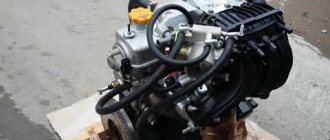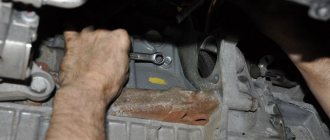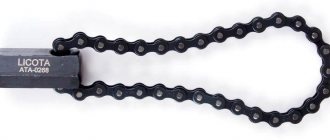Since December 2015, the H4M engine, produced by the Renault-Nissan alliance for six years, has appeared in the VAZ arsenal. The H4M engine has a “successor”, that is, a modified version. It is called H4Mk and was created in 2012. The power of the two different engines is different - it is equal to 110 and 117 hp. And the VAZ plant produces exactly the H4M engines, and without any modifications - the firmware and parameters remain the same. The H4M motor is designed for two new products at once: for the Vesta sedan and for the X-Ray crossover. But the Lada Vesta with a Nissan engine is not yet available.
There are rumors about a 114 horsepower engine, but this is not true information! More details about this in the article: Lada Vesta with a 114 hp engine!
Specifications HR16DE/H4M
Comparative table of engine characteristics: VAZ 21129, 21179 and HR16DE/H4M:
| Engine model | VAZ 21129 | HR16DE/H4M | VAZ 21179 |
| Symbol | 1.6 l, 16 cl | 1.8 l, 16 cl | |
| Type | Petrol, 4-cylinder, in-line | ||
| Working volume, l (cm 3) | 1,6 (1596) | 1,6 (1596) | 1,8 (1774) |
| Cylinder diameter, mm | 82 | 78 | 82 |
| Piston stroke, mm | 75,6 | 83,6 | 84 |
| Compression ratio | 10,5 | 10,7 | 10,3 |
| Number of camshafts | 2 | ||
| Number of valves per cylinder | 4 | ||
| Timing drive type | Toothed belt | Chain | Toothed belt |
| When the timing belt breaks | Valve bending (until 08/15/18) | — | Valve bend |
| Rated net power, kW/hp. (at crankshaft rotation speed, min -1) | 75/106 (5500) | 81/110 (5800) | 90/122 (6000) |
| Maximum net torque, Nm (at crankshaft speed, min -1) | 148/4200 | 150/4000 | 170/3750 |
| Minimum crankshaft rotation speed at idle, min -1 | 840 | 675-725 | 840 |
| Weight, kg | 92,5 | n.d. | 109,7 |
| Ignition system | Electronic, contactless, microprocessor controlled | ||
| Cylinder operating order | 1-3-4-2 | ||
| Supply system | Multiport fuel injection | ||
| Fuel | Unleaded gasoline with octane number 95* | ||
| Availability of neutralizer | Eat | ||
| Toxicity standards | Euro 5 | ||
| Oil consumption depending on fuel consumed, % | 0,3 | 0,3 | |
| Oil volume in the lubrication system of an engine with a cast (light-alloy) sump (manual transmission), l | 4,1 | 4,7 | 4,1 |
| Engine oil quality class according to API* | SL, SM or SN | ||
| Engine oil viscosity grade according to SAE* | see motor oil | see motor oil | see motor oil |
| Resource, km | 200 000 | ||
* — the recommended fuel is indicated; if it is not available, the manufacturer allows the use of gasoline with an octane number of at least 92.
Generator: Valeo brand, made in Türkiye
The generator of the same French brand Valeo, but already made in Turkey, confused us at first - instead of the usual orange transformer varnish, the windings are covered with protection that is not uniform in color. However, as they say, “the speed should not be affected.” But we consider the fact that the terminals from the winding were not soldered, but simply crimped, to be a disadvantage. Not durable.
In addition, dismantling the component (replacement) is extremely difficult due to its location. The generator is clamped by the air conditioning compressor from below and its tubes - from the end and from the top, and from the belt drive side, as well as the tension roller, by the wall of the engine compartment. As a result, when replacing the generator, you will have to remove the air conditioning compressor (if there is one, of course).
Three more Valeo components found: starter (Poland), release bearing and climate control unit (Czech Republic). The French company is one of the world's main manufacturers and suppliers of components for car factories, including, of course, fellow countrymen from Renault, from whom it migrated to AvtoVAZ.
Features of the HR16DE/H4M engine
The cylinder block has two camshafts and four valves per cylinder. The camshafts are driven by a silent chain with an automatic tensioner, which is designed for the entire service life of the engine.
Thermal clearances in the valve drive are regulated by selecting pushers (there are no hydraulic compensators). The oil pump is located at the top of the engine sump and is driven by a chain. The main and additional catalytic converters are located in the exhaust pipe.
The HR16DE/H4M engine is equipped with an automatic variable valve timing system, which improves the filling of the engine cylinders in all operating modes. To do this, phase regulators rotate the sprockets of the intake camshafts relative to the shafts themselves. The phase regulators are controlled by a hydraulic drive, which uses the oil pressure of the engine lubrication system. The flow of oil is controlled by a phase change solenoid valve, which in turn controls the ECU (electronic engine control unit).
Gearbox: Renault brand, made in Russia
The Lada Vesta is equipped with a French 5-speed manual transmission JH3-510. The transmission housing is cast at VAZ's own metallurgy. Actually, all assembly is carried out in Tolyatti.
The choice in favor of a foreign gearbox was made due to the fact that in the native VAZ engineers were unable to overcome extraneous noise, in particular the hum of gears. It is known that the French gearbox costs AvtoVAZ 20% more than the domestic one.
Let us recall that the AMT “robot” was created on the basis of a domestic gearbox, in which the problem of noise (in particular, a muffled howl in second gear) is still relevant. We have no complaints about the performance characteristics of a manual transmission.
Characteristics of the N4M engine
The engine block is lightweight due to the fact that it is made of aluminum , unlike its predecessor in the line of French engines. The timing belt is replaced with a chain, and the 16-valve cylinder head is also cast from aluminum .
The H4M engine is equipped with an electronic throttle valve and eight injectors : two per cylinder.
- produced from 2006 to present
- has a precise displacement of 1598 cm³
- has different power depending on the modification: 108 - 117 horses
- torque also varies: 142 - 158 Nm
- compression ratio 10,7:1
- lubricant change frequency: every 15,000 km , better than 7,500 km
- Oil consumption: no more than 500 g per 1000 km
- engine oil volume 4.3 liters
- belongs to the environmental class Euro-4, Euro-5
- AI-95 fuel
- power supply system - injector
- Aluminum is used as a material for the cylinder block
- number of cylinders - 4
- 4 valves per cylinder
- has a piston stroke of 83.6 mm
- standard cylinder diameter 78 mm
- operating temperature 84°C to 100°C
- H4M runs on a timing chain drive
Technical features of N4M
The H4M engine was designed by the automaker Nissan for the Tiida and Note . The new product was demonstrated in 2004 at an exhibition at the Paris Motor Show . The engine design complied with the technical canons of the early 2000s: a lightweight four-cylinder block made of aluminum with a timing chain drive , 16 valves in the cylinder head without hydraulic compensators .
Electronic valve , injection through two injectors in each cylinder. A clear advantage was compliance with stringent environmental requirements of Euro 5 .
In 2015, this engine was successfully adopted by the Volzhsky Automobile Plant under the name N4Mk.
H4M Service
Having earned positive marks for its practicality , low fuel consumption and compliance with all environmental standards , the N4M engine turned out to be quite unpretentious in maintenance.
- According to the manufacturer, the timing chain mechanism has an unlimited resource ; if the chain breaks, it does not bend the valve , although in practice replacement is desirable after a run of 150 thousand km.
Disadvantages and weaknesses of the H4M motor
Despite its reliability and efficiency , the H4M motor still has a number of disadvantages and weaknesses.
The main problems that arise during operation are associated with increased oil consumption and knocking noises from under the hood.
If noticeable consumption of H4M oil began while the mileage was low , then it is advisable to select a different oil . If the problem appears after a mileage of 120-150 thousand km , then it is probably time for the engine to be overhauled .
How the body is made
Let's admit: the Lada Vesta, which is attractive in our opinion, is very well assembled in terms of its bodywork. The measured gaps are everywhere at the level of a couple of millimeters. Well, the softness and silence with which the doors close are completely worthy of applause. And everything would be absolutely wonderful if we had not started studying the car from below.
In general, of course, there is no “crime”. The first thing that caught my eye was the sloppiness of the anti-corrosion treatment, in the category of “we’ll apply it here, but it’ll do just fine.” It can be seen that some areas were treated over the protective film, which was then torn off along with the protection. Moreover, in the same place it was done with completely different quality (carefully and clumsily).
An incident was discovered under the hood - at the factory, a piece of paper was attached to one of the side members with tape, apparently with an example of a color called “platinum”, in which it was necessary to paint the car from the inside. Actually, they painted this piece of paper, forgetting to tear it off - naturally, there was a stripe under it without painting.
The rear beam mounts, apparently, are not original. One of the “ears” for the bolts was left protruding into the wheel arch.
Another point is the accuracy of internal bends and connections of individual body parts. Between some of them there are considerable technological holes into which, of course, dirt, salt and road chemicals will get clogged. Considering that some of these connections have not been exposed to anticorrosive agents, they are likely to become centers of corrosion, especially in the wheel arches.
Tuning N4M
An affordable option to tune the H4M engine is to do chip tuning , changing the standard indicators upward. This method, judging by the reviews, will not give a noticeable gain and sensations that the car enthusiast expects from this procedure.
If you want to really increase power, you need a 4-2-1 spider exhaust manifold and forward flow on a two-inch exhaust pipe . By adding to this a cold air intake and chipping of the internal combustion engine computer, it is possible to achieve power figures of 125 horses .
But the real result is achieved by installing a turbine . For example, a small option for a standard piston: “VW K03” with an intercooler and pipe kit , a corresponding manifold , high-performance injectors and direct-flow exhaust. Moving in this direction, it is possible to achieve power of 160 and even 200 hp.
Fuse box and its housing: Renault brand, made in Romania
The fuse box comes entirely from the Logan model, as evidenced by the Renault logos on the body and the Romanian manufacturer Capirom. True, AvtoVAZ reported that in the near future the company will change its supplier to a local one - from the Samara region.
We had no questions about the unit itself, but in the process of a scrupulous study by the electricians, a very interesting point emerged. Attention was drawn to two fuses that were not indicated either on the diagram or in the instructions. A study of the electrical circuit revealed that during a sudden voltage surge (for example, when lighting up a Vesta with the engine running), these fuses may burn out, resulting in the battery stopping charging. And what’s most insidious is that the driver of a discharged car will not know about it - no electrical “paths” to the dashboard (indicator lamps) could be found. Whether the reason will be revealed when connecting the standard diagnostic system in the absence of an error that pops up is also a question.
What cars was H4M installed on?
The H4M engine was harmoniously and rationally introduced into the creation of a large number of Nissan and Renault and was successfully adapted to each model.
This engine is installed in Nissan Terrano D10 from 2016 to the present day.
Since 2012, Renault cars , such as Arkana 1 (from 2019 ), Fluence 1 (from 2012 to 2017 ), Megane 3 (from 2013 to 2016 ), Sandero 2 , Duster 1 , Kaptur 1 , Megane 4 , Logan 2 and Sandero 2 Stepway (since 2016 ), Logan 2 Stepway (since 2018 ).
Lada cars also received this engine: X-Ray hatchback (since 2016 ), Vesta sedan 2180 , Vesta SW 2181 , Vesta Cross 2180 , Vesta SW Cross 2181 and X-Ray Cross (since 2019 ).











